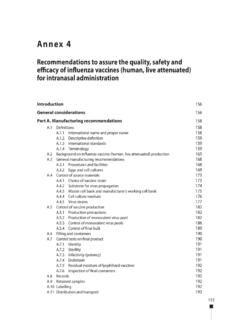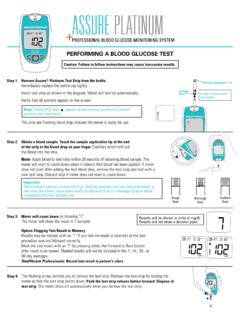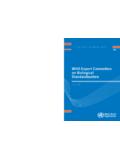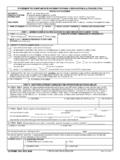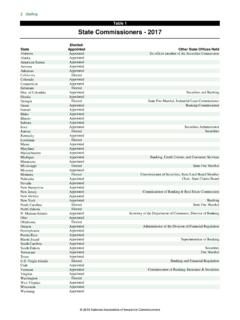Transcription of Good Epidemiologic Practice (GEP)
1 Guidelines and Recommendations to assure good Epidemiologic Practice (GEP). Long Version German Society for Epidemiology (DGEpi). In Collaboration with the German Association for Medical Informatics, Biometrics, and Epidemiology (GMDS), German Association for Social Medicine and Prevention (DGSMP). German Region of the International Biometrics Association (DR-IBS). With revisions after evaluation April 2004. With supplement by implementation rule for good Practice Secondary Data Analysis (GPS). July 2008. Editors of the First Edition: B rbel-Maria Kurth Robert Koch-Institute Berlin Hans-Werner Hense Institute for Epidemiology & Social Medicine, University of M nster Wolfgang Hoffmann Bremer Institute for Prevention Research and Social Medicine In collaboration with.
2 Wolfgang Ahrens, Birgit Babitsch, Heiko Becher, Maria Blettner, Sabine Brasche, Hermann Brenner, Gottfried Enderlein, Karin Halina Greiser, Ingeborg Jahn, Karl-Heinz J ckel, Wolf Kirschner, Thomas Kohlmann, Angela Liese, Matthias M hner, Ulrich Mueller, Ralf Reintjes, Andreas Stang, Matthias Wjst Editors of the Revised Edition after Evaluation Wolfgang Hoffmann Institute for Community Medicine, Ernst-Moritz-Arndt University Greifswald Ute Latza Chair, Occupational Medicine, University Hospital Hamburg-Eppendorf Claudia Tersch ren Institute for Community Medicine, Ernst-Moritz-Arndt University Greifswald In collaboration with: Klaus Berger, Manuela Bergmann, Andreas Dahl, Konstanze Fendrich, Sylke Gierer, Rolf Holle, Ingeborg Jahn, Michael Sch mann, Karen Steindorf 2.
3 Foreword In December of 1997, an international commission, assembled by a mandate of the chair of the German Research Foundation (DFG), formulated the following offer: Scientific Professional societies should, as part of their scope of action, develop and publish standards of good scientific Practice on which their members are to be obliged.. As a result, during a membership meeting on March 17th, 1998, the German Epidemiological Foundation (DAE) authorized its Working Group on Epidemiological Methods to develop a blueprint for Guidelines and Recommendations to assure good Epidemiological Practice (GEP). A first draft of these recommendations was openly discussed during a two-day workshop in May, 1999 at the Robert Koch Institute in Berlin.
4 The corrections and modifications that arose from this discussion were applied by an editorial committee and presented to the boards of directors of the DAE, the GMDS and the DGSMP, and the German Region of the International Biometrics Association. In an extensive consensus-building process, the current recommendations were adopted by all participating professional associations in February, 2000. The Guidelines and Recommendations to assure good Epidemiological Practice (GEP). will be available in both a short and a long version. The short version is intended to provide a concise overview and comprises therefore only the 11 guidelines and associated recommendations. The long version contains additional commentary regarding each guideline.
5 It is intended that the capacity of the guidelines to assure good Epidemiological Practice will be evaluated during a two-year trial period, after which the document will be revised if necessary. These guidelines and recommendations are addressed to everyone involved in the planning, preparation, execution, analysis, and evaluation of epidemiological research, as well as research institutes and funding bodies. The guidelines and recommendations presented here are based on current widely accepted standards of epidemiological research already in international use, and were arrived at as a result of the above- mentioned consensus process. The purpose of epidemiological research is to investigate the determinants of health, as well as the causes, incidence, progression and outcomes of diseases in human populations, or rather in well-defined population groups.
6 Epidemiological studies are primarily observational, and are therefore to be differentiated from randomized intervention studies in clinical research. The guidelines presented here should serve to establish standards of quality for epidemiological research in Germany. They should help to eliminate scientific fraud, to ensure transparency in research, and to promote trusting collaborations among scientists. The guidelines, however, should not be as limiting or inflexible as to threaten the freedom of scientific research in Epidemiology. Rather, the guidelines should define the framework within which epidemiological research can be used to its fullest benefit, in all of its facets and relating to all of its areas of application.
7 It is quite possible that in special cases reasonable deviations of the guidelines can and sometimes even ought to be made. Such cases are capable of remaining consistent with good epidemiological Practice via explicit description of the nature of the deviation and its valid justification. Although many of the elements described here are already accepted as 3. good scientific Practice in Epidemiology, these guidelines will be particularly important with regard to both the execution of upcoming studies and the planning of future ones. It is important for all people involved in the Practice of Epidemiology to be aware of the main features of good scientific Practice and to implement them in daily Practice .
8 Serious cases of scientific fraud threaten the value of Science itself, as they erode the public's trust in Science as well as the relationships of scientists among one another. Epidemiology, however, depends on both of these basic elements, which should therefore be safeguarded for the future by the Guidelines and Recommendations to assure good Epidemiologic Practice presented here. December 1999. Foreword to the Revised Edition As stated in the preamble, upon the adoption of the guidelines, it was decided that an evaluation would be conducted after two years of use and the recommendations would be revised if necessary. In September of 2001, the DAE assigned the Working Group on Epidemiological Methods in conducting this evaluation.
9 The Joint (Cross-Sectional). Working Group for the Evaluation of the Guidelines for good Epidemiological Practice was established to develop the content and format of the evaluation instrument; this group consisted of members representing the Epidemiological Methods Working Group, as well as members of other workgroups of the DAE and its umbrella organizations. The objective was to obtain the most representative overview possible of the recognition, application, and usefulness of the guidelines from a wide range of people involved in epidemiological research in Germany. All participants were requested to suggest improvements or rather provide feedback on the formulation of the individual guidelines and recommendations.
10 The Joint (Cross-Sectional) Working Group produced a six-page, 34-item questionnaire to evaluate the guidelines. The Department of Epidemiology of Health Care and Community Health of the Institute for Community Medicine at the Ernst-Moritz-Arndt University Greifswald coordinated the data collection. After consulting with the board of directors of the DAE and its umbrella organizations, the questionnaire was sent by mail to all members of the DAE and to the members of the professional association of Epidemiology of the DGSMP. The evaluation form was sent to a total of 457 members, of whom 138 (30%) responded. The participants of the members' poll from the DAE and DGSMP were, as an alternative to the paper version, given the option of filling out the questionnaire online, with an individualized password for access to a secured webpage.

